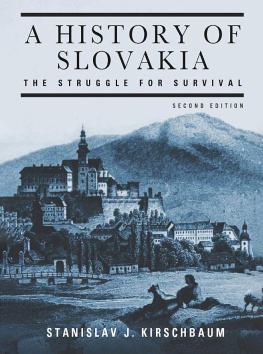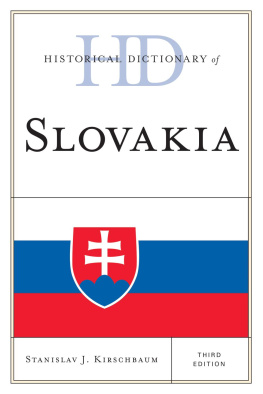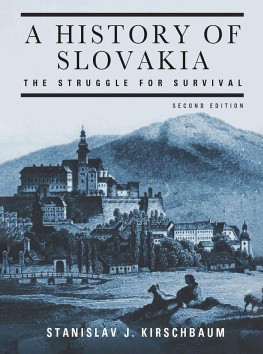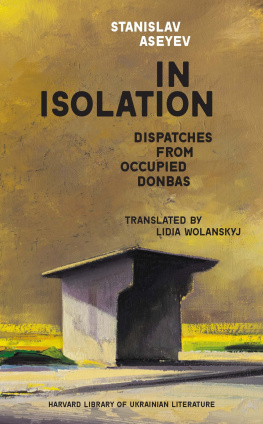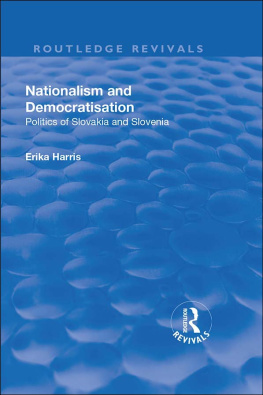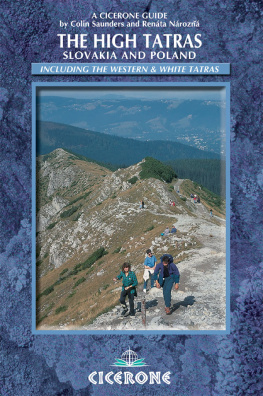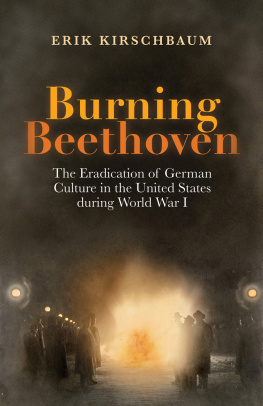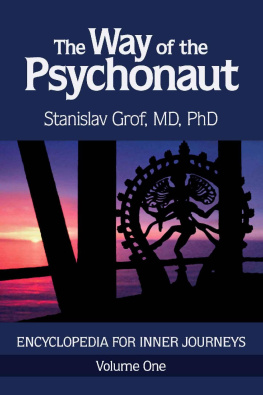Stanislav J. Kirschbaum - A History of Slovakia: The Struggle for Survival (2005) 2nd Edition
Here you can read online Stanislav J. Kirschbaum - A History of Slovakia: The Struggle for Survival (2005) 2nd Edition full text of the book (entire story) in english for free. Download pdf and epub, get meaning, cover and reviews about this ebook. year: 2005, publisher: Griffin, genre: Religion. Description of the work, (preface) as well as reviews are available. Best literature library LitArk.com created for fans of good reading and offers a wide selection of genres:
Romance novel
Science fiction
Adventure
Detective
Science
History
Home and family
Prose
Art
Politics
Computer
Non-fiction
Religion
Business
Children
Humor
Choose a favorite category and find really read worthwhile books. Enjoy immersion in the world of imagination, feel the emotions of the characters or learn something new for yourself, make an fascinating discovery.
- Book:A History of Slovakia: The Struggle for Survival (2005) 2nd Edition
- Author:
- Publisher:Griffin
- Genre:
- Year:2005
- Rating:4 / 5
- Favourites:Add to favourites
- Your mark:
- 80
- 1
- 2
- 3
- 4
- 5
A History of Slovakia: The Struggle for Survival (2005) 2nd Edition: summary, description and annotation
We offer to read an annotation, description, summary or preface (depends on what the author of the book "A History of Slovakia: The Struggle for Survival (2005) 2nd Edition" wrote himself). If you haven't found the necessary information about the book — write in the comments, we will try to find it.
Stanislav J. Kirschbaum: author's other books
Who wrote A History of Slovakia: The Struggle for Survival (2005) 2nd Edition? Find out the surname, the name of the author of the book and a list of all author's works by series.
A History of Slovakia: The Struggle for Survival (2005) 2nd Edition — read online for free the complete book (whole text) full work
Below is the text of the book, divided by pages. System saving the place of the last page read, allows you to conveniently read the book "A History of Slovakia: The Struggle for Survival (2005) 2nd Edition" online for free, without having to search again every time where you left off. Put a bookmark, and you can go to the page where you finished reading at any time.
Font size:
Interval:
Bookmark:
A HISTORY OF SLOVAKIA
The Struggle for Survival
Second Edition
Stanislav J. Kirschbaum

To my mother
my daughters Olga, Sophia and Alexandra
and in memory of
Maria Kapsanova Loydl
and my father
The story told in the first edition about Slovakia and its people ended in 1993, when the second Slovak Republic came into being. From the reviews in scholarly journals and a great number of personal messages, I experienced the satisfaction of knowing that the book was well received. Not only was it filling a gap in the literature, but it was also contributing to an understanding of the role the Slovaks have played in Europe. The history of Slovakia pointed to a thread that led to independence, but it left, on the other hand, the door open to many outcomes as far as the future was concerned. It was only when Slovakia joined the European Union on 1 May 2004 that another chapter in that countrys history was completed. The time had come to tell the story of how membership in the European Union had come about and also how it was connected to Slovakias history.
No book is without faults; errors creep in. In addition to a new chapter, this edition corrects some of the factual errors found in the first one, errors that reviewers kindly pointed out and for which I am grateful. I also wish to thank those who helped me with the research or with the writing of the additional chapter; any errors or omissions are entirely mine. My thanks go to Pavol Kristof and Jozef Simoncic in Trnava and Jan Carnogursky, Milan Bucek, and Jozef Rydlo in Bratislava for the information they provided so quickly and generously upon request. I also wish to thank Philippe Garigue, my very good friend and mentor, for his helpful suggestions. Finally, to my darling spouse, Tiiu, I owe a debt of gratitude not only for her stylistic and grammatical help, but above all for her love, encouragement, and patience.
SJK
Toronto
August 2004

01. The Slovak Republic of 1993

02. The Great Moravian Empire

03. Slovak counties (zupy) in Hungary

04. The First Czechoslovak Republic 19181938

05. The Slovak Republic of 1939
MISUNDERSTOOD, MISINTERPRETED, OR UNKNOWN?
The events in the autumn of 1989 in Central Europe did more than just put an end to the Cold War and bring down the Iron Curtain; the collapse of the Communist regimes meant the end of the exclusive hold of Marxism in the social sciences there. This is a welcome development for the nations of the region whose academics, researchers, and writers can once again study their societies, especially their history, openly and not along ideologically and politically dictated lines. In many instances, this means a serious revision of what has been for the last four decades the official history of those nations. And for no nation can such a perspective be more welcome than for the Slovaks.
In the last forty-five years in Slovakia, history was written under serious constraints and limitations. A similar situation also existed in the West; there were and, now to a lesser degree, still are particular conditions that affect the writing of Slovak history. However, just as in Slovakia, scholarship in the West on the Slovaks is undergoing change, not only because of the new situation, but above all because of the status it had in the past. To understand why this change is taking place, it is important to understand how, until the recent events in Eastern Europe, Western scholarship approached Slovak history. Our aim is to assess this situation and its problems rather than to offer an exhaustive examination of the literature on Slovak history in Western languages.
In 1979, the Nestor of Slovak historians abroad, Joseph A. Mikus, published an essay entitled Slovakia, a Misunderstood History.
In the face of this kind of political, but also scholarly, approach, one can well understand that there developed a particular interpretation of Slovak history in the West. However, Mikus also indicates that certain Czech scholars did not accept their colleagues approach.
If the writing of history is important to the nations of Eastern Europe, one may well ask why Mikus refers to Czech scholars where Slovak history is concerned? Are there no Slovak historians? Could it be that Slovak history was misunderstood in the West because it is unknown? It is to these questions that we now turn.
The writing of the history of the Slovaks is not a recent phenomenon, but its impact has been limited because of domestic as well as external developments. The first works were published in the seventeenth century and were written in Latin. As a result, they reached a small audience. Unlike the Czechs, for whom Frantisek Palacky wrote a historyit was first published in German and later translated into Czechthat had a profound impact at a crucial moment in their national development in the nineteenth century, the Slovaks did not have historians of equal stature until well into the twentieth. A strong oral tradition celebrated in song and poetry heroes and happy events and deplored villains and disasters. However, little, particularly of a scholarly nature, was written.
Late in the nineteenth century, at the height of Magyarization, a handful of Slovak scholars set out to write about various aspects of their nations past. Not surprisingly, the output was not phenomenal. The first general outlines of Slovak history were published by Anton Bielek in his Dejepis Slovakov od
The creation of Czecho-Slovakia had a definite but paradoxical impact on the writing of Slovak history. Unlike the situation in Hungary, where educated Slovaks had been subjected to Magyarization, the new state allowed the development of education and scholarship in Slovakia. Yet at the same time, the writing of Slovak history was not encouraged. The reasons for this will be discussed. Nevertheless, despite a number of difficulties, a generation of Slovak scholars was being trained under Jozef Skultetys leadership to research and write the history of their nation. Specific and sectoral work was done by people such as Daniel Rapant, It was aimed at the general public, in particular Americans of Slovak origin, and is not a scholarly work. Despite these efforts, Slovak history continued to be unknown in the West.
The Communist seizure of power in 1948 had a peculiar impact on the writing of Slovak history. Once again, the West learned little of Slovak history from native Slovak historians.
Fortunately, Slovaks abroad were able partially to fill the void. They too, however, suffered the consequences of the ideological division of Europe. They were denied access to Slovak archives and libraries and became embroiled in a major ideological battle. Nevertheless, this postwar generation of Slovak emigres managed to do remarkable work, not just as scholars, but also as organizers of scholarly conferences and editors of journals. They launched three scientific journals,
Next pageFont size:
Interval:
Bookmark:
Similar books «A History of Slovakia: The Struggle for Survival (2005) 2nd Edition»
Look at similar books to A History of Slovakia: The Struggle for Survival (2005) 2nd Edition. We have selected literature similar in name and meaning in the hope of providing readers with more options to find new, interesting, not yet read works.
Discussion, reviews of the book A History of Slovakia: The Struggle for Survival (2005) 2nd Edition and just readers' own opinions. Leave your comments, write what you think about the work, its meaning or the main characters. Specify what exactly you liked and what you didn't like, and why you think so.

